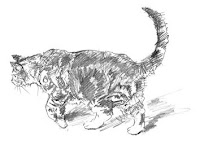At
the SCBWI picture book retreat this summer, we had a debate about illustration
notes.
Some quite well-established authors and illustrators argued that we
should be allowed to include these to communicate clearly to the editor how the
book should work. How else would we explain everything?!
We
put the question to one of the editors who came to speak. "Definitely not!" she
said.
Hmm... So illustration notes are a big no, no...
Hmm... So illustration notes are a big no, no...
Oh dear, we all wailed. As authors who don’t draw, this is so hard! However will we communicate everything we’re imagining in our heads? How will we be sure the editor “gets” our stories?
OK, deep breath. Remember two things:
1.
Picture book editors know how to imagine the pictures. It's their job.
When
you add illustrator notes, you are interrupting the flow of the words as the
editor is reading your story. It is distracting and highly annoying.
Editors
are skilled at reading picture book texts and imagining the pictures. They
instinctively know how to match a really good story with just the right
illustrator to add an extra level of detail, humour and excitement.
2.
The pictures are the illustrator’s job.
They don’t want to be told how to do their job . . .
When
you add detailed illustrator notes, it is as if you are trying to micro-manage
the illustrator. Picture book illustrators are skilled at imagining stories and
scenes when they read a story. They don’t want to be told how it should look.
Chances are, they will add layers to your story that you never even imagined. This
is why picture books are so exciting to work on – they evolve.
Remember,
too, that once a book is commissioned, editors will offer authors the
opportunity to share their vision and comment on the roughs and artwork.
But,
how, oh how, will you be able to get across your story clearly without
illustration notes?
First,
take them ALL out.
Eek, I know, it's hard. Now, pretend you are all cosy on the story carpet, ready to hear a story read aloud to you. Read the story out loud. It should be attention-grabbing!
Eek, I know, it's hard. Now, pretend you are all cosy on the story carpet, ready to hear a story read aloud to you. Read the story out loud. It should be attention-grabbing!
You should be able to hear it flow without the need for any
explanation. The story has to be strong enough to stand alone. If it doesn’t
make sense, you’ll need to add more context, more specific scenes, more vivid
dialogue.
But
what about the word count, I hear you wail!
So
can I never include illustration notes? Are there any exceptions to this rule?
One
technique you can try is to include any really important notes concerning the
story in the cover letter to the editor. This is where, for instance, you can
explain that your main character is a particular animal or that at the end of the story,
there is an unexpected visual twist.
Visual irony: if your story relies on
visual irony, for
example, with the text saying one thing, and the illustrations showing the
reality, you can include a very brief
illustration note.

Page
turn surprise: sometimes, surprises are revealed when a page is turned, in
which case a short, bracketed note will be enough.


Visual
twist or wordless page: if your story relies on a visual joke or there is a
wordless page, you can include a brief note to this effect.




Novelty books: in the case of novelty books, you can consider mocking up your idea simply in order to convey how the narrative works.

Do you have any illuminating or frustrating experiences with illustration notes that you'd like to share?
Natascha Biebow
Author, Editor and Mentor
 Blue Elephant Storyshaping is an editing, coaching
and mentoring service aimed at empowering writers and illustrators to
fine-tune their work pre-submission. Check out my NEW small group coaching courses!
Blue Elephant Storyshaping is an editing, coaching
and mentoring service aimed at empowering writers and illustrators to
fine-tune their work pre-submission. Check out my NEW small group coaching courses!
 Blue Elephant Storyshaping is an editing, coaching
and mentoring service aimed at empowering writers and illustrators to
fine-tune their work pre-submission. Check out my NEW small group coaching courses!
Blue Elephant Storyshaping is an editing, coaching
and mentoring service aimed at empowering writers and illustrators to
fine-tune their work pre-submission. Check out my NEW small group coaching courses!
Natascha is also the author of Elephants Never Forget and Is This My Nose?, editor of numerous award-winning children’s books, and Regional Advisor (Chair) of SCBWI British Isles. www.blueelephantstoryshaping.com
































